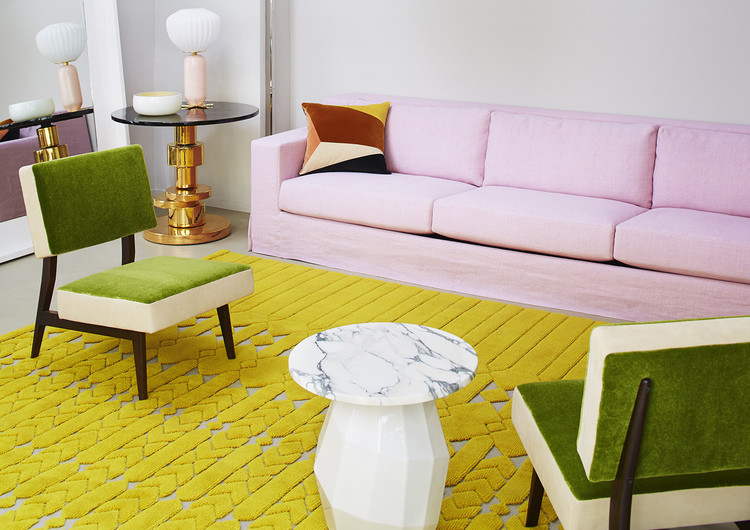Based in Southern France, high-end woven rug manufacturers La Manufacture Cogolin combine time-honored methods with an unwavering passion for design and innovation to create the most beautiful pieces of woven art. Bringing French éclat to the forefront, the carpets boast striking designs and exceptional palettes, perfectly suited for any and every setting.
Found in some of the world’s top establishments, La Manufacture Cogolin‘s rugs are loved by everyone from interior designers to homeowners, cruise line operators, hoteliers and restaurateurs. An internationally-renowned brand whose name is synonymous with exquisite carpet mastery, La Manufacture Cogolin’s history dates back more than 90 years.
It all began in 1928, in a quaint French village just a stone’s throw from Saint-Tropez, when textile engineer Jean Lauer purchased the Cogolin rug factory. This marked the start of an exciting and remarkable adventure that would span the next century of carpet-making. Immediately, visionary Jean Lauer set to work transforming his new acquisition from a factory specializing in silkworm culture and hand-knotted rugs into a workshop focused on innovation. He installed 19th-century mechanical Jacquard looms; imported a host of new techniques for knotting and weaving and brought in artisans from Lyon and Aubusson to complement the skills of the largely Armenian workforce. Thanks to these advances, the factory was able to produce a wider variety of rugs, which in turn led to Cogolin’s increasingly widespread recognition throughout the 1930s as a leading creator of bespoke products.
It wasn’t long before Cogolin’s creations could be found gracing some of the world’s most prestigious interiors, from Versailles to the Élysée Palace to the most luxurious French ocean liners. This acclaim further led to collaborations with some of the most celebrated artists and decorators across Europe, such as Jules Leleu, Jean-Michel Frank, Christian Bérard, Sir David Hicks and Jean Cocteau. The designs created in partnership with these icons continue to line the La Manufacture Cogolin archives to this day as a testament to its place in contemporary carpet history.
As the decade of its centenary approached, La Manufacture Cogolin experienced a rebirth in 2010 when it joined House of Tai Ping, a group comprised of several of the world’s leading carpet brands, bound together by a shared philosophy, artisanal expertise and commitment to excellence. With the support of this new partnership, Cogolin has risen once again to prominence on the international stage, balancing its storied past with innovations that point toward the future, all while producing rugs for the most discerning clientele across Europe, the United States and Asia.
With its looms restored, buildings renovated, colour palette reimagined and fresh materials sourced, the workshop has turned over a new, more contemporary leaf. The ateliers which were were novated in 2013, still respect the style of the founding period and honor the original structure. The building also continues to house a rare treasure: the company’s 19th century Jacquard handlooms.
“The workshop is the heart of the company” says Sarah Henry, Managing Director of La Manufacture Cogolin. “I don’t know anyone who has entered the weaving workshop without being captivated by these ancient wooden looms that have been in place here since the 1930s.”
The looms are an irreplaceable legacy, and the nucleus of the identity and savoir-faire of the brand. They require great skill to use and only a select few employees have the expertise to handle them. Like musical instruments, the looms must be constantly tuned through the adjustment of the weights and tensions during the weaving process. From this complex operation, the beauty of the intricate Cogolin rugs emerges.
Together with its modern approach, Cogolin continues to use the time honored technique of hand-knotting as an ode to its heritage. This craft lives on in the Cogolin et les Mains du monde (Cogolin and the Hands of the World) line, which utilizes the expertise perfected by Cogolin over the past century to bring archival designs back to life.
“We have adapted colors and patterns in our recent collections to respond to the needs of contemporary clients, but the techniques and gestures remain those of the early 19th century” says Sarah Henry.
An atelier of inimitable craftsmanship, La Manufacture Cogolin continues into its second century with a bold and ambitious direction that celebrates the brand’s storied legacy while charting a course for the future with passion, talent and elegance. Preserved with vigilance and respect since the end of the 19th century, the French atelier has conserved its essence and savoir faire from one generation to the next. This includes the training of new employees, which is passed down from generation to generation, and can take months because of the intricacy of the processes.
As each loom and the hand of each weaver are unique, each rug must be woven by a single weaver from start to finish, making every rug that leaves the manufactory a true work of art. A veritable labour of love, the are five keys elements that underpin the production of an authentic Cogolin rug:
- Seams: The Cantres and Textures rugs of the brand are composed of individual panels, each 70-cm wide, that are hand-sewn into a custom rug. The seams are visible, especially on the back of the rug.
- Patterns: Woven on Jacquard handlooms, the rugs of the Manufacture incorporate graphic and geometric repeat patterns and can be finished with or without a border.
- Weaving in 2 heights: The patterns of the Cantres rugs are made by the juxtaposition of an elevated pile and a low ground, like a woven velvet fabric – either in tone-on-tone or in bright color combinations.
- Finishing: Produced to order following the client’s selected dimensions, colors and pattern, the Flatweave rugs, often woven in raffia, have an exposed woven edge – a sign that the rug is bespoke. The Cantres and Textures rugs are finished with hand-sewn hems.
- Materials and colors: Dyed to order for each client project, the yarns used are soft, thick, and of the highest quality.
Rugs can be realized in undyed natural yarns – in the manner of the style popular in the 1960’s and 1970’s – or in a palette of modernist colors, inspired by the company’s archives from 1930 – 1950.
From the selection of raw materials to the delivery of the finished product, the French brand masters its production from beginning to end to ensure the sustainability of its historic savoir-faire and to guarantee the excellence of its products. An ambassador of French craftsmanship and savoir-faire, La Manufacture Cogolin takes care to manage its environmental impact and create a safe and healthy environment for its employees.
“We develop long-term relationships with reliable local suppliers in order to limit our carbon footprint, maintain control over the quality of production, and ensure that our partners respect environmental standards and good employment conditions,” underlines Sarah.
Renovated in 2013 while respecting the original architecture of the buildings, the ateliers now have optimal insulation following the replacement of all of the windows and roofs, and electricity has been updated to current code requirements – all of which have reduced the energy consumption of the atelier, and have improved the comfort and safety of the employees of this family-sized company.
“We also work hand-in-hand with the public health services and ergonomists to follow health issues and improve production gestures for our work that his entirely realized by hand,” adds Sarah.
The rugs of La Manufacture Cogolin are produced to precise and demanding requirements, beginning with the yarns that are spun in Europe to the atelier’s specifications from materials of the highest quality, such New Zealand wool, European and Egyptian cotton, French and Belgian linen and jute, and raffia from Madagascar. The yarns are then dyed to order in France to the specifications of each bespoke rug.
Once delivered to the atelier, the white yarns are inspected before they are sent out for dyeing, and each dye lot is controlled for accuracy by the atelier’s staff before the yarns are delivered from the dye house to the workshop. Controls are also in place at each step of production – pattern repeats are measured regularly throughout the weaving process of each rug to make sure that weaving is consistent and corresponds to the norms for each pattern, and each woven panel is measured and inspected before assembly by the sewing team. The finished rug is measured and inspected twice to ensure that it conforms to the client’s order before it is packed for shipment. To guarantee safe delivery, the brand works with consistent partners for shipments all over the world – including white glove delivery and installation in locations in Europe and the United States.
For the French House, the choice to continue to manufacture in France is a means to guarantee not only the quality of its products, but also its close relationships with its clients – a tradition dating back to the early days of the company. Evidence of the satisfaction and loyalty of privileged clients, the Manufacture has numerous letters and photos in its archives sent to thank the production team – including hand-written letters from clients such as Karl Lagerfeld or the Picasso family. These trusted relationships are built over time, with thoughtful communication through each step of the project.
The process begins with a client visit at the showroom, in a design office, or at a client’s home to choose a pattern/design, materials, colors and the size of the rug – with the expert advice of the sales team to ensure that the rug will best correspond to the style of the home and use following installation.
“Our clients – both professionals and end-users – are very involved in their projects and we take seriously our responsibility to provide the best advice and solutions for their installations” affirms Sarah.
During the production process, which takes on average 10 weeks and up to 16 weeks for large sizes, clients often receive photos of their rugs on-loom so that they can witness the exceptional production. Once finished, the rug is delivered with a certificate of authenticity signed by the weaver and by the Managing Director, guaranteeing the origin and quality of the product – unique pieces woven on the same looms since the 1920’s with a savoir-faire passed from one generation to the next.
“I am frequently contacted by museums or auction houses such as Southeby’s or Christies to authenticate rugs woven 50-80 years ago” concludes Sarah Henry, “which we are able to do thanks to our system of serial numbers and archives that contain information on the original orders.”
Some of the newer designs have also seen much popularity, such as the The Jazz Age. Created by Sarah Henry, this collection is an homage to the Art Deco period, closely tied to the origins of the company established in 1924. Inspired by architectural details emblematic of the 1920s that were used for façades, metal work and textiles, The Jazz Age collection unveils six graphic patterns revisited in the particular technique and style of the manufacture. And for the first time in the history of the house, gold and silver Lurex have been added to the ground of the six rugs made in wool, cotton and jute, an audacious combination that brings depth and brightness to the Art Deco geometrical patterns.
Nord/Sud, a series of hand-knotted rugs created by French designer and interior architect Stéphane Parmentier, and Jardin Intérieur by India Mahdavi are some of the brand’s other much-loved collections. The atelier’s incredible creations have been installed in countries as far as Russia and India, and their portfolio of impressive projects can be viewed here.
(Photo: India Mahdavi – Jardin intérieur)
Article source : https://frama.link/sCXzLjGV






